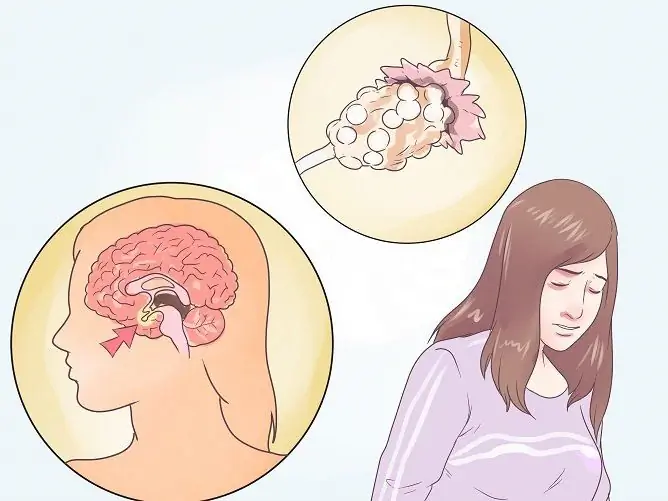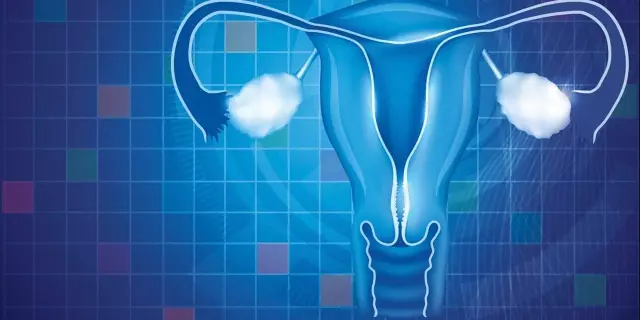- Author Rachel Wainwright [email protected].
- Public 2024-01-15 19:51.
- Last modified 2025-11-02 20:14.
SHBG - what is it?
The content of the article:
- SHNG properties
- Concentration in blood
- What determines the level of SHBG
-
Factors that increase the content of SHBG in women
- Hyperestrogenism
- Liver disease
- Hyperthyroid conditions
- Taking medications
- Indications for SHBG research
- Video
During the diagnosis and treatment of pathology of the reproductive system, the level of SHBG is determined - what is it? SHBG, or sex hormone binding globulin, is a glycoprotein that transports sex steroids in the blood. It is also often referred to as sex steroid-binding globulin (STBG). Determination of its concentration is of great clinical importance, since the level of SHBG affects the activity of sex hormones and changes in various diseases.

SHBG in the blood is determined in the diagnosis of a number of pathologies, such as infertility or menstrual irregularities
SHNG properties
SHBG is synthesized by liver cells, consists of two polypeptide chains and has a single binding site for both male steroid hormones - androgens, and for female - estrogens. Steroid biologically active substances are not water-soluble, therefore, in order for them to reach target tissues, carrier proteins are needed.
Transport proteins are of two types: non-specific and specific. One of the representatives of the first group is albumin, the second is globulin that binds sex hormones.
CCSS, forming a bound form of androgens and estrogens, performs several tasks:
- protects the human body from excessive accumulation in the blood and the effect on tissues of free forms of sex steroids;
- provides a physiological reserve of steroids in the form of a bound fraction;
- protects androgens and estrogens from destruction by enzymes;
- prevents the filtration of small molecular weight hormones through the renal glomeruli.
Sex hormones have different affinities for SHBG. The maximum ability to bind to the transport protein belongs to the biologically active form of testosterone - dihydrotestosterone. Only 2% of this hormone is in the bloodstream in a free state, the rest is in conjunction with SHBG (60%) and albumin (33%). The content of the free form of estradiol and progesterone in the plasma also does not exceed two percent, but the binding with SHBG is 38% in the first, and only 0.6% in the second. The remaining percentages are attributed to other carrier proteins.
Concentration in blood
The intensity of the synthesis of transport globulin in the liver depends on sex steroids: estrogens increase, and androgens decrease its production. Therefore, the globulin that binds sex hormones in women is increased, compared to men, by almost two times.
The norms of SHBG in the blood serum of both sexes (unit nmol / l) are as follows:
| Age range | Women | Men |
| Up to 2 years | <64 | <97 |
| 2-4 years | 33-135 | 27-110 |
| 4-8 years | 23-121 | 28-131 |
| 8-12 years old | 26-112 | 29-150 |
| 12-14 years old | 19-89 | 13-102 |
| Adults under 60 | 18-114 | 13-71 |
| Over 60 years old | 17-154 | 15-67 |
In practice, an assay for determining the level of sex steroid-binding globulin is performed as an adjunct to the study of total testosterone in blood plasma. It is this androgen, as indicated earlier, that has the highest affinity for the transport protein under consideration.
The interpretation of the results is combined with the calculation of the free androgen index, or free testosterone. It is determined by the ratio of total testosterone to SHBG levels and is expressed as a percentage.
| Age | Men | Women |
| 20-49 years old | 35.0-92.6 | 0.297-5.62 |
| Over 50 years old | 24.3-72.1 | 0.187-3.63 |
The deviation of indicators both in one and the other direction is influenced by many factors.
What determines the level of SHBG
The bound and free fractions of sex steroids are in a state of stable equilibrium in the blood serum. The specific gravity of the hormonally active form depends on the concentration of androgens, estrogens, as well as on the content and binding capacity of the transport protein. This is of great diagnostic value, because those conditions that change the level of SHBG directly affect the level of free hormones.
Factors that increase the content of SHBG in women
In women, an increase in the level of sex steroid-binding globulin in the blood can be observed when:
- hyperestrogenism;
- liver diseases;
- human immunodeficiency virus infection;
- hyperthyroid conditions;
- taking medications;
- anorexia.
Hyperestrogenism
A condition such as hyperestrogenism - a high content of female sex hormones in the blood, stimulates the excessive production of SHBG, which is necessary for transporting an increased amount of steroids. The causes of primary hyperestrogenism caused by increased synthesis of estrogen in the ovaries are as follows:
- hormone-producing ovarian tumors (granulosa cell, theca cell);
- hypothalamic tumors leading to excessive synthesis of gonadotropin-releasing hormone;
- gonadotropinoma - a pituitary adenoma with hormonal activity;
- adrenal tumors.
Liver disease
Viral, medicinal, toxic hepatitis are accompanied by cytolysis syndrome. During cytolysis, the destruction of the hepatic cell - hepatocyte, occurs, accompanied by the release of intracellular enzymes into the blood. This becomes possible due to a violation of the permeability of membranes and organelles of liver cells. As a result, the processes of metabolism and estrogen excretion slow down.
Hyperthyroid conditions
Hyperthyroidism is an endocrine syndrome, manifested by increased synthesis of thyroid hormones - thyroxine (T4) and triiodothyronine (T3). The main reasons for the development of the syndrome:
- diffuse toxic goiter;
- nodular toxic goiter;
- thyroiditis with a subacute course;
- pituitary form of resistance to thyroid hormones;
- nephrotic syndrome.
In hyperthyroid conditions, the conversion of androgens into estrogens increases in the tissues and, as a result, the level of globulin that binds sex hormones increases.
Taking medications
Some drugs, especially when used uncontrolled, increase the sex steroid-binding globulin levels. Most often, an increase in SHBG levels is associated with the intake of:
- combined oral contraceptives;
- phenytoin (antiepileptic drug).
A physiological increase in the concentration of SHBG is observed during pregnancy, especially in the later stages. This is due to a significant change in hormone metabolism. After the onset of menopause, the content of sex hormone-binding globulin increases by about 1.5% annually in women over 60 years of age.
Indications for SHBG research
Venous blood serves as a material for research in determining the level of sex steroid-binding globulin. Blood samples from the cubital vein can be collected on any day of the menstrual cycle. The analysis is taken in the morning on an empty stomach, alcohol is excluded (at least 12 hours in advance) and smoking (at least 1-2 hours in advance).
Usually, the purpose of the examination is to assess the hormonal balance of the reproductive system. The specialist can recommend the patient to study for SHBG when:
- decreased libido (sex drive);
- infertility;
- hirsut syndrome (male-pattern excess hair growth);
- violation of the menstrual cycle;
- predicting the risk of developing preeclampsia (a condition that complicates the course of pregnancy and manifests itself with edema, increased pressure, protein in the urine).
An increase in the level of sex steroid-binding globulin leads to significant shifts in the ratio of active and associated fractions of hormones. To normalize the concentration of CCGS, it is necessary to find out the reason that caused the increase in laboratory parameters. Only etiological treatment will be successful.
Video
We offer for viewing a video on the topic of the article.

Anna Kozlova Medical journalist About the author
Education: Rostov State Medical University, specialty "General Medicine".
Found a mistake in the text? Select it and press Ctrl + Enter.






